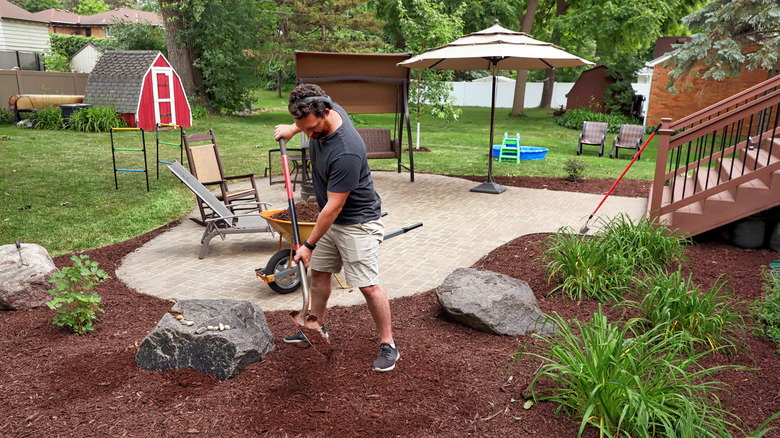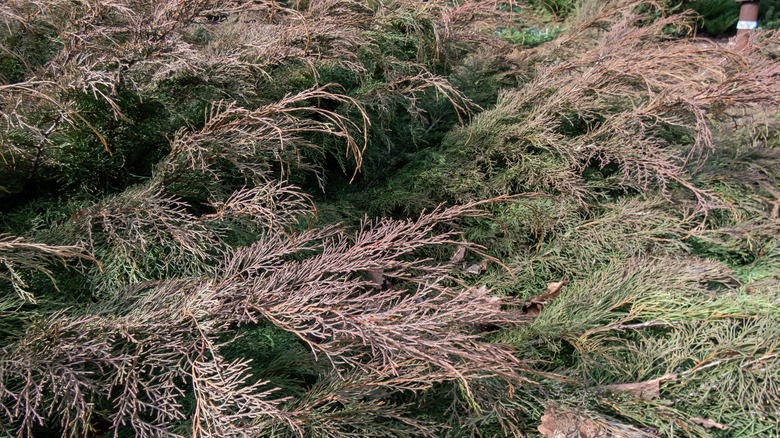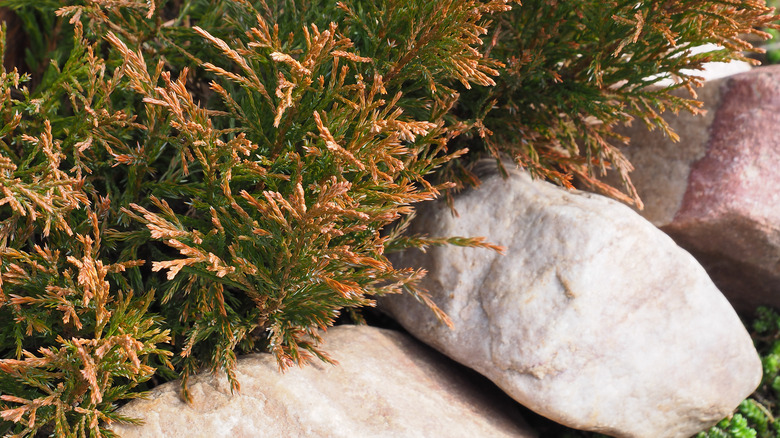The Fast-Growing Landscaping Choice That Boasts Fantastic Feathery Foliage
We may receive a commission on purchases made from links.
Looking for a plant to replace that disease-prone juniper that's been giving you so much trouble? Growing wild above the timberline in mountainous eastern Siberia is a sprawling, slow-growing conifer relative that was only just discovered in 1921 and started being sold to gardeners in the U.S. and around the world in the 1970s. The plant in question is the Siberian cypress (Microbiota decussata), a plant with sprays of foliage that resemble an odd but pretty cross between the aforementioned juniper and a fern.
What, outside of its juniper-esque vibes, makes this plant worthy of a spot in your backyard? Despite being a conifer, Siberian cypress is definitely not a tree. Instead, it grows low and waterfall-like, making it useful as a groundcover or for protecting erosion-prone slopes. Those in the coldest parts of the U.S. will rejoice — this is a chill-hardy plant that puts on a display of purple-blue fall and bronze-brown winter foliage. It tolerates partial shade and thrives even in the harshest sun. Plus, caring for Siberian cypress is easy for even the least green-thumbed gardener.
You may see Siberian cypress referred to as Russian arborvitae, Russian cypress, and Siberian carpet cypress at nurseries and online. The plant is monotypic, meaning it's the only species in its genus, though now there are a few commercially available cultivars, including the sought-after 'Celtic Pride' (sometimes called just 'Prides'), 'Condavis' Fuzzball, 'Condrew' Drew's Blue, and 'Gold Spot'. Despite its attractive qualities, the shrub isn't quite mainstream; look for it at specialty nurseries or online. For example, a Green Promise Farms Proven Winners Microbiota decussata Celtic Pride in a gallon container costs about $80.
Siberian cypress is right at home in the coldest and driest parts of your garden
One of the most attractive features of Siberian cypress is its extreme cold tolerance, perhaps unsurprisingly given its native habitat. The shrub doesn't just survive in winters of minus 40 degrees Fahrenheit (Zone 3); it thrives. In fact, the cultivar 'Celtic Pride' is hardy to Zone 2a. It can be grown up to Zone 7 but will struggle in hot and humid southern U.S. gardens. Growers are also attracted to the low, spreading mat of foliage Syberian cypress forms. The plant won't get much taller than 1 foot nor wider than 10 feet, making it the perfect ground cover shrub, though these limits are educated guesses given the plant can live a couple of centuries at least. The shade tolerance so touted as a selling point of this plant may be overemphasized. While the plant does okay in some shade, it grows most vibrantly in a sunny spot.
Curating a garden full of fall color? Then you'll love that the needles on your conifer trees and shrubs turn brown — and Siberian cypress is no exception. As summer blends into fall, the foliage transforms from vivid emerald-blue to a dramatic bronze-purple-brown with teeny round, scaled berry-cones. Pair it with heathers, other conifers, and ornamental grasses for even more drama. Perhaps best of all, Siberian cypress is rarely bothered by pests or disease. It regularly appears on lists of deer-resistant garden plants and isn't prone to the phomopsis blight that so often affects its ground cover juniper cousins. The 'Celtic Pride' cultivar is particularly disease resistant.
How to make best use of Siberian cypress in landscape design
Siberian cypress numbers among the many beautiful ground covers that are great for preventing soil erosion. Let it colonize and subsequently stabilize embankments, retaining walls, windy slopes, and hillsides. It makes a great addition to a no-mow yard in mass plantings. The plant fits into a wide range of garden styles. Its fall color and structured, cascading growth habit lend it to Asian or Zen gardens, while that same rustic look works well in a cottage garden. The shrub doesn't need much water, making it the perfect addition to rock, coastal, and cooler climate xeriscape gardens. Its feathery summer and dramatic fall foliage makes it the good choice for a cutting garden — that is, a garden you grow so you can take cuttings from the plants for ornamental indoor displays. Likewise, take advantage of the wispiness to enhance a garden bed border.
Pair it with other evergreens like rhododendrons, hollies, pieris, and mountain laurels and, in the summer, hostas, or allow it to sprawl under Japanese maples. Don't have an in-ground garden? Let Siberian cypress spill over the edges of large containers and raised planters — just ensure you maintain good watering practices. The shrub occasionally suffers from root rot (Phytophthora water mold) if overwatered or planted in poorly draining soils. It might also be sensitive to urban pollution, so stick to planting it in your backyard rather than in front or street-side yards.


